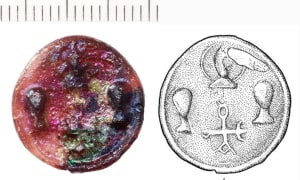Private churches and public synagogues – how devotion and ambition shaped the religious landscape of Israel in Late Antiquity

Late Antiquity (4th–7th centuries A.D.), saw a surge of private church construction in the land of Israel and the broader Near East, driven by Christian patrons’ desire for prestige and devotion to local saints, according to new research by Prof. Jacob Ashkenazi of Kinneret College on the Sea of Galilee.
Published in the Levant journal, Ashkenazi's findings also show a clear contrast with nearby Jewish communities, which focused their resources on single, centralized synagogues that served as village community centers.
Ashkenazi has studied the subject of churches and synagogues in Late Antiquity in the Levant for several decades, publishing numerous papers and articles on the subject.
In his recent paper, Ashkenazi notes that in classical Greek and Roman times, elites funded public amenities like bathhouses and theaters to fulfill civic duties and also to boost social standing through a conspicuous display of wealth and generosity. In Christian communities of Late Antiquity, this tradition evolved, with wealthy individuals channeling resources into the building of churches.
“In classical times…affluent people used to contribute to the public sphere,” Ashkenazi told the Times of Israel in a recent interview. “They funded the construction of bathhouses, theaters and amphitheaters, and sponsored public spectacles and festivals.”
“In Christian times, the phenomenon just slightly transformed, as the wealthy started to fund churches,” he noted.
The large number of churches in such a small area has surprised archaeologists.
“In the Roman province of Palestine alone, more than 700 churches have been documented in archeological contexts, not to mention the churches mentioned in historical sources,” Ashkenazi said. “It is really unbelievable.”
Ashkenazi saw the phenomenon firsthand in the Galilee, where he and colleague, Prof. Motti Aviam, excavated seven churches and surveyed over 70 in Western Galilee alone. For instance, the small village of Khirbet Bata in modern Carmiel had seven small churches, while Hippos (Susita), with about 2,000 residents, boasted eight churches, six of which appear to be private.
Ashkenazi notes that scholars traditionally attributed the phenomenon to theological disputes among Christian denominations. However, Ashkenazi argues that the churches’ architecture, design, and artifacts show no significant theological differences.
“I concluded that religious disputes are not enough to justify the number of churches and that the explanation was much simpler,” he said. “At a time when everyone was a believer, wealthy individuals sought to both give and receive by building churches that would serve the community while affirming their social status.”
Ashkenazi argued for a similar view in an earlier paper published in 2018 in The Journal of Ecclesiastical History, where he claimed that the abundance of rural churches in the Levant, with clearly wealthy local patrons, was the result of a kind of competition between wealthy lay people and ecclesiastical leaders within the town boundaries.
In that paper, Ashkenazi argues that building family churches in the countryside, just outside the borders of the village, was a power play, enabling landowners to acquire social capital and influence, without publicly confronting ecclesiastical leadership. The churches were often built to commemorate martyrs, family members, or even lower-level clergy.
In contrast to the building of private churches, Jewish communities in the Near East took a different approach. Their synagogues, often adorned with elaborate mosaics and donor inscriptions, served as public community centers.
“Synagogues were public buildings,” Ashkenazi explained, “they served as community centers, where people gathered, met, learned and read the Torah.”
Private synagogues were almost nonexistent, he explained.
“Synagogues served a different purpose than churches and therefore needed to be the one place where all the community came together.”
Churches built by local elites, who sometimes contributed to a village’s central church, often had dual entrances – one for the family and one for the public. Sometimes the churches were even constructed within, or partially within, the patrons’ own homes. Inscriptions found in these churches offer insights into their patrons.
“Most inscriptions start with the donor’s name and sometimes mention other family members, such as his wife and children,” Ashkenazi said. In contrast, central churches, typically larger, often featured inscriptions beginning with “In the time of” followed by the bishop’s name, placed at the entrance or near the altar.
The private churches were frequently dedicated to lesser-known or local saints, reflecting personalized religious expression, while public churches from the time rarely evidenced veneration of saints.
“In the entire Roman province of Palestine, only three churches were dedicated to St. Peter – arguably a universal figure,” Ashkenazi noted. “In contrast, around 20 were devoted to St. George, who was still a local saint in the 5th century, long before he rose to broader fame in the Middle Ages.”
The archaeological evidence paints a picture of a Christian landscape where private devotion and social ambition intertwined to create unique expressions of worship.
Ashkenazi researched another aspect of religious and social dynamics in Late Antiquity. While Christian elites built numerous churches, both public and private, to blend piety with prestige, Jewish communities usually invested in singular, communal synagogues.
This divergence reflects not only religious differences but also distinct approaches to community identity and public space during a period of dramatic transformation.

The All Israel News Staff is a team of journalists in Israel.
You might also like to read this:
















